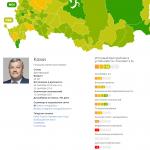Floksal: instructions for use and reviews
Floksal is a local drug with a broad spectrum bactericidal, antibacterial action, used in ophthalmology.
Release form and composition
- eye ointment: homogeneous, color - light yellow (3 g in tubes, in a cardboard bundle 1 tube);
- eye drops: transparent, color - light yellow (5 ml each in polyethylene bottles with a dropper cap or dropper bottles, in a cardboard bundle 1 bottle or dropper bottle).
Composition of 1000 mg eye ointment:
- additional components: white petrolatum - 847 mg, liquid paraffin - 100 mg, wool fat - 50 mg.
Composition of 1 ml eye drops:
- active ingredient: ofloxacin - 3 mg;
- additional components: 1M sodium hydroxide solution - 2.5-3.5 mg, 1M hydrochloric acid solution - 4.5-5.5 mg, sodium chloride - 9 mg, benzalkonium chloride - 0.025 mg, water for injection - up to 1 ml .
Pharmacological properties
Pharmacodynamics
Ofloxacin belongs to the fluoroquinolones. It has an antibacterial (bactericidal) effect. Active against aerobes, obligate anaerobes, facultative anaerobes and some other bacteria such as Chlamydia.
Certain types of microorganisms have acquired resistance, the frequency of which depends on the region and changes over time. That is why, in order to prescribe the correct therapy, it is necessary to have information about local resistance. Cross-resistance between ofloxacin and other fluoroquinolone drugs may also occur.
Types of microorganisms most sensitive to ofloxacin:
- gram-negative aerobic bacteria: Acinetobacter baumannii, Acinetobacter lwoffii, Enterobacter cloacae, Escherichia coli, Haemophilus parainfluenzae, Haemophilus influenzae, Klebsiella pneumoniae, Klebsiella oxytoca, Moraxella catarrhalis, Proteus mirabilis, Serratia marcescens;
- gram-positive aerobic bacteria: Bacillus spp., Staphylococcus aureus.
Types of microorganisms that can acquire resistance to ofloxacin:
- gram-negative aerobic bacteria: Pseudomonas aeruginosa, Stenotrophomonas maltophilia;
- gram-positive aerobic bacteria: Corynebacterium spp., Enterococcus faecalis, Staphylococcus epidermidis, Staphylococcus aureus, methicillin-resistant strains of Streptococcus pneumoniae.
Types of microorganisms with innate resistance to ofloxacin: Gram-positive aerobic bacteria Enterococcus spp.
Pharmacokinetics
The effectiveness of the drug depends on the ratio of the highest concentration of ofloxacin in the tissue and its minimum concentration that suppresses the pathogen.
With repeated use, the drug accumulates in the tissues of the eye in therapeutic concentrations. The maximum concentration of ofloxacin is reached 1-2 hours after the administration of the drug 5 times a day with a 5-minute exposure after each injection. 5-6 hours after the peak concentration, it decreases to zero.
The half-life of the drug (with regular use) is 3-7 hours.
Indications for use
- diseases of the anterior eye of infectious and inflammatory etiology, which are caused by microorganisms sensitive to the action of ofloxacin - dacryocystitis, corneal ulcer, ophthalmic chlamydia, blepharitis, barley, keratitis, conjunctivitis (treatment);
- bacterial infections after surgical operations, as well as eye injuries (treatment and prevention).
Contraindications
- period of pregnancy and lactation;
- individual intolerance to the components of the drug.
Instructions for use Floksal: method and dosage
Eye ointment
Eye ointment Floksal with a strip of about 1.5 cm is placed behind the lower eyelid of the affected eye 2-3 times a day. An increase in the frequency of use up to 5 times a day is indicated in cases of treatment of ophthalmic chlamydia.
When conducting combination therapy with other ophthalmic drugs, Floxal should be used last.
Course duration - up to 14 days.
Perhaps the combined use of two dosage forms of the drug.
Eye drops
Floksal eye drops, according to the instructions, are prescribed 1 drop 2-4 times a day. The drug is instilled into the lower conjunctival sac of the affected eye.
When conducting combination therapy with other ophthalmic drugs, the minimum interval between instillations should be at least 5 minutes.
Side effects
Possible disorders: photophobia, itching and dryness of the conjunctiva, conjunctival hyperemia (transient), discomfort in the eyes, allergic reactions, lacrimation, burning sensation.
In rare cases, dizziness may develop.
Overdose
There is no information on overdose.
special instructions
Wearing contact lenses during treatment is not recommended.
Due to the potential for photophobia, sunglasses are recommended and prolonged exposure to bright light should be avoided.
After using Floksal, a temporary deterioration in visual acuity is possible, which must be taken into account while driving a car and performing work with mechanisms.
Use during pregnancy and lactation
Despite the lack of data on the negative effect of the drug on the fetus, it should not be used by pregnant and lactating women.
drug interaction
There are no data on the development of significant interactions with other drugs / substances.
Analogues
Analogues of Floksal are: Vigamox, Dancil and Uniflox.
Terms and conditions of storage
To store in the place protected from light at a temperature up to 25 °C. Keep away from children.
Shelf life - 3 years.
Floksal after opening the package can be used up to 1.5 months.
Floxal eye ointment from barley is used to treat infectious and post-traumatic lesions of the anterior sections of the eye. The drug belongs to the second generation of antibiotics from the group of fluoroquinolones. Bactericidal drug for topical use.
The Latin name of the ophthalmic drug is Floxal. The antibacterial drug is dispensed by prescription. The tube contains 3 g of a light yellow, odorless substance. The tip is used to place medication under the lower eyelid.
The active substance Ofloxacin is the basis of the eye ointment.
1 ml of drops and 1 g of ointment Floksal contain 3 mg of an antibiotic.
Excipients - white petrolatum, paraffin, lanolin.
Indications for use
Ophthalmic eye gel has bactericidal properties, negatively affecting the process of bacterial reproduction.
Ofloxacin is active against:
- Staphylococcus aureus.
- Meningococcus.
- coli.
- Salmonella.
- Chlamydia.
- Haemophilus influenzae.
Variable sensitivity to the drug have:
- Streptococci.
- Tuberculosis bacillus.
- Pseudomonas aeruginosa.
- Mycobacteria.
Cannot be treated with fluoroquinolone Bacteroids, Clostrids, Pale treponema.
Floksal is prescribed for the treatment of inflammatory processes in the eyes and adjacent membranes caused by a bacterial infection:
- mucous membrane (conjunctivitis);
- inflammation of the eyelids (blepharitis);
- cornea (keratitis);
- lacrimal sac (dacryocystitis).
Chlamydial conjunctivitis of all forms can be cured by Floxal:
- trachoma;
- paratrachoma;
- blennorrhea;
- basin;
- epidemic in children;
- with Reiter's syndrome.
As a prophylactic and therapeutic agent, it is prescribed after an injury and surgery in front of the eyes.
Staphylococcus aureus is the cause of external and internal barley and chalazion (meibomite) on the eyelid. Floksal is prescribed as an antibacterial agent in the treatment of internal purulent inflammation of the eyelid.
Floksal has no contraindications for the treatment of children, starting from infancy.

The duration of treatment is determined by the doctor. The maximum duration is 14 days. The minimum course is 5 days.
Multiplicity of application of Floksal: 3-4 times a day. To apply the ointment, it is necessary to move the lower eyelid and squeeze a strip 1-1.5 cm long from the tube.
The requirements specified in the treatment of Floxal ointment in the instructions for use:
- cleanly washed hands;
- do not touch the tip of the tissues of the eye;
- after laying the ointment, keep the eye closed for 1-2 minutes;
- with a light finger pressure, distribute the medicine under the eyelids.
With internal barley at the site of localization of the inflammatory process and after opening the abscess, the ointment is applied 2 times a day under the lower eyelid. The course of treatment is 14 days.
Chlamydial infections are stopped by 5 times the use of an antibacterial agent during the day, the course duration is determined by the doctor.
For preventive purposes, Floksal is used 1 time per day.
Do not use soft contact lenses during eye gel treatment. Rigid contact lenses are removed for the duration of the procedure, put on after 20 minutes.
You should protect your eyes from bright sunlight during the course of therapy: wear sunglasses.
Floksal is combined with other drugs. The simultaneous use of several ophthalmic agents is possible with a time interval of 5-10 minutes. Ointment is used last, after eye drops.
It is possible to alternate Floksal ointment and drops of the same name: in the morning and afternoon hours - drops, at night - ointment.
In childhood, the permissible dosage is 3 times a day.
It is necessary to limit the driving of vehicles and work with mechanisms for the duration of Floxal therapy.
The ointment is stored in a place protected from light, out of the reach of children, at a temperature of up to 25 gr. Shelf life - 3 years. Use the opened tube within 6 weeks.

Contraindications and side effects
Intolerance to Ofloxacin, an allergic reaction to auxiliary components are contraindications for the use of the drug Floxal.
Possible reactions to the introduction of the drug into the conjunctival sac:
- lacrimation;
- itching, burning;
- photophobia;
- redness of the conjunctiva;
- veil on the eyes;
- swelling of the eyelids;
- rash, irritation on the eyelids;
- dizziness.
Preservation and intensification of these side effects require a doctor's consultation, drug withdrawal, and the appointment of alternative therapy.
In rare cases, an allergic reaction can cause anaphylactic symptoms in the form of edema:
- Quincke;
- oropharynx;
- faces;
- around eyes.
The drug requires withdrawal and medical attention.
Analogues
Analogues of Floksal include drugs containing Ofloxacin:
- Dancil drops, country of origin - India;
- Uniflox drops, country of origin - Slovakia;
- ointment Ofloksatsin, country of origin - Russia.
Drops and ointment have the same treatment regimens, contraindications, side effects. Differences relate to the use of ophthalmic agents in childhood:
- Dancil, Uniflox is not prescribed for children under one year old.
- Ofloxacin is contraindicated in children under 15 years of age.
According to the mechanism of action, Floksal is identical to cheap analogues, and drops:
- Tsipromed (active substance Ciprofloxacin), manufacturing country - India;
- Normax (Norfloxacin), India;
- Tobrex (Tobramycin), Belgium;
- Albucid (Sulfacetamide), Russia;
- Levomycetin (Chloramphenicol), Russia, Belarus;
- Oftaquix (Levofloxacin), Finland;
- Sulfacyl sodium (Sulfacetamide), Russia.
Floksal eye ointment is produced in Germany, Russia.

Price
The cost of Floksal is from 225 to 297 rubles. surpasses the price of similar drugs.
Identical medicines can be purchased at a pharmacy (average price, rubles):
- Levomycetin - 45;
- Albucid - 70;
- Sulfacyl sodium - 75;
- Ofloxacin - 90;
- Uniflox - 105;
- Tsipromed - 134;
- Dancil - 164;
- Tobrex - 204;
- Oftaquix - 230.
The cost of drops and ointments Tobrex and Levomycetin is the same.
The choice of the drug depends on the combination of useful properties, the presence of contraindications, side effects and affordability.
Phloxal - a German drug that has a bactericidal effect, is actively used in ophthalmology. Refers to antimicrobial drugs that can block the DNA molecules of bacterial cells.
The advantage of the drug over similar ones is the possibility of treating infants.
Compound
At the core of the composition ofloxacin .
As additional components use:
- sterile water;
- benzalkonium chloride;
- hydrochloric acid;
- sodium hydroxide.
The drug is available in a plastic bottle, which is equipped with a dropper dispenser.

Sold in a cardboard box, the kit includes instructions for use.
Indications for use
Floxal is prescribed in the treatment, accompanied by suppuration, inflammation and redness.
Can be used as preventive means against inflammatory processes, infectious infections after the eye and surgery.
Contraindications
Drops forbidden use with hypersensitivity to the components of the composition and a tendency to develop allergic reactions.

With caution are prescribed to patients with disorders of the central nervous system, tendon lesions, heart pathologies, stroke.
According to the clinical data, the drops do not have a negative effect on the fetus, so they can be used during pregnancy. Also, the active components of the drug are not transmitted to the baby through breast milk, so the medicine is safe during lactation. But still, it is strongly not recommended to use the drug in self-medication, without a doctor's prescription!
Possible adverse reactions, restrictions on use
Even short-term use of the drug can cause adverse reactions:
- hyperemia;
- burning sensation;
- increased;
- headache;
- dizziness.
Many patients complain about. Often there is discomfort, a feeling of a foreign body in the eyes.

When any discomfort against the background of the use of Floksal, it is necessary to suspend the use of the drug and notify the doctor about the ailments that have arisen.
During therapy, it is forbidden to wear. When going outside, it is necessary to wear it, since many patients experience it during the treatment period.
The use of drops can cause lacrimation, photosensitivity and dizziness, so you should refrain from driving vehicles and working at hazardous sites.
Instructions for use
Drops are dripped into the conjunctivitis sac of the diseased eye. Buried drop by drop up to 4 times a day.

The maximum duration of therapy is no longer than 15 days.
Higher therapeutic results can be achieved with the simultaneous use of drops with.

You must first drip eye drops, then apply a strip of ointment to the upper eyelid, wait until it is completely absorbed. The ointment is applied three times a day.
In the event that the patient is prescribed complex treatment with the use of several drugs in the form of drops, it is unacceptable to use them at the same time. Between instillations it is necessary to make an interval of at least 10 minutes.
Application for children
The drug is safe for children from infancy. A special children's form of the drug does not go on sale; standard Floxal is used for the treatment of children.
The child is instilled drop by drop into the sore eye, the number of procedures per day is at the discretion of the attending physician (depending on the age of the patient and his diagnosis).

Drops can be used no longer than 12 days.
For the treatment of eye diseases in children, you can use and together with drops. But it is necessary to ensure that the drug does not get into the eye of the child.
Price
Approximate cost - within 250 rubles. It belongs to potent drugs, therefore it is sold for sale only by prescription.
It is important to note: after opening the bottle, it can be stored and used for no longer than 6 weeks!

Reviews
Gennady, 46 years old, Kaliningrad:
Floksal was prescribed to me by a doctor for treatment. Moreover, he recommended me a complex treatment - the simultaneous use of drops and ointment. Drops dripped into the eye 4 times a day, after instillation, treated the affected area with ointment. The doctor prescribed me therapy for 10 days. But I noticed improvements on the second day. To consolidate the effect, a full course of treatment was completed. Very pleased with the result. Didn't notice any side effects.
Elizabeth, 32 years old, Krasnodar:
In damp weather, conjunctivitis constantly begins to torment me. Every autumn I suffer from this scourge! The eyes become very red and start to fester. After another such attack, I went to the doctor, he prescribed Floxal drops for me.
Already after a few instillations I felt a significant improvement in well-being. But the doctor insisted that I use the drug for at least a week, since it belongs to antibiotics and treatment cannot be interrupted.
During treatment, headaches and itching in the eyes were periodically observed.
Nadezhda, 24 years old, Petrozavodsk:
My daughter (2 years old) began to have very watery eyes, after a while suppuration appeared. The doctor prescribed us Floksal drops. I buried the eyes of the child in the morning and in the evening, for a week. A good remedy, but after instillation, my daughter began to rub her eyes, the drug caused a slight itch.
Ophthalmologists note that Floksal is recognized as one of the highest quality drugs, which allows you to cope even with advanced diseases. It is this drug that doctors trust the eyes of their patients.
According to experts, patients generally tolerate the action of the antibiotic well, only in rare cases there are complaints about the appearance of adverse reactions.
Analogues
At the moment, city pharmacies are supplied with a large assortment of ophthalmic drugs. Among them, you can find drugs that have an effect identical to Floxal.
The best analogues based on ofloxacin include:

Approximate cost - 130 rubles for a bottle.

Cost - average 85 rubles for a bottle.

The cost of the drug is approx. 155 rubles .
The price of the presented preparations is indicated for a bottle of 5 ml. If you compare their cost with Floksal in identical packaging, you will notice that analogues are much cheaper.
It is important to remember that if you want to replace Floxal with a cheaper drug, you should consult with your doctor.
The ophthalmic drug Floksal is a high-quality antibacterial drug.
It is used for the treatment of ophthalmic diseases, as well as in the complex treatment of third-party diseases accompanied by lacrimation and suppuration of the eyes. Refers to medicines from group B - potent drugs dispensed from pharmacies strictly according to a doctor's prescription.
The use of drops can provoke the appearance of many adverse reactions, so therapy should be carried out only under the supervision of a specialist. Self-medication is strictly unacceptable, since illiterate use of the drug can lead to serious consequences.
Video
Floksal eye drops are an antibiotic from the group of fluoroquinols with an extensive spectrum of action. The drug is active against many pathogens that provoke eye infections. The medicine is prescribed for conjunctivitis, keratitis, as well as after various injuries and operations on the organs of vision, to prevent the development of a secondary infection. Drops are quite expensive.
Release form, composition and packaging
Floxal is produced in the form of eye drops, the active substance is ofloxacin. 1 ml of the drug solution contains 3 mg of ofloxacin, which indicates a 0.3% dilution.
The drug is light yellow in color, poured into plastic bottles of 5 ml, with a dosing device. The bottles are packed in the original cardboard box along with instructions for use.
The composition of the drug contains a number of additional substances that enhance the effect of the main component. This includes benzalkonium chloride, hydrochloric acid, sodium hydroxide and purified water.
pharmachologic effect
Floksal eye drops contain ofloxacin, which belongs to the fluoroquinols. This substance blocks the DNA enzyme in bacterial cells, preventing their reproduction. The drug has a detrimental effect on a number of gram-negative and gram-positive bacteria. Some anaerobes and microorganisms that produce beta-lactamase are sensitive to the drug.
After application, the drug is found in almost all parts of the visual organs. With repeated use, the drug accumulates in the vitreous body. A large amount of the active substance is contained in the eye fluid. With the therapeutic use of the drug, 5-6 hours after the end of the use of drops, this figure drops to zero.
Contraindications
The instructions for use indicate a number of contraindications for which the drug cannot be used. Contraindications include:
- Particular sensitivity to individual components of the drug.
- Pregnancy period.
With caution, it is worth prescribing the drug to people who once had an allergy to fluoroquinols. Caution is also needed when prescribing to lactating women.
If there are contraindications to the use of eye drops, you should consult your doctor.
Method of application and dosage
Floksal is prescribed for barley, conjunctivitis and a number of other eye diseases. The dosage and duration of the course of treatment is determined by the doctor, depending on the age and condition of the patient. If the doctor has not prescribed another treatment, then adhere to the dosage prescribed in the instructions. Eyes are instilled 4 times a day, one drop in each eye. It is desirable to carry out the procedures at approximately the same time interval.
The instructions for use indicate that the drug can be used in children older than 1 year. In fact, doctors often prescribe Floxal even to newborns. These drugs are instilled in the eyes of children immediately after birth to avoid infection.
Wash your hands well with soap before handling your eyes. The patient is laid on the bed or comfortably seated so that the head is thrown back. With one hand, the lower eyelid is gently pulled back and one drop of the drug is dripped into the conjunctival sac.
Floksal is often prescribed for dacryocystitis in young children. The drug is dripped into the eyes, and then the area of \u200b\u200bthe lacrimal canal is massaged.
During pregnancy and lactation
The instructions for use indicate that Floxal is not recommended for prescribing to pregnant women and during breastfeeding. The effect of the drug on these categories of patients is poorly understood. Despite prohibitions, ophthalmologists prescribe medication during pregnancy and lactation if there is no alternative. In this case, the expected benefit of treatment must necessarily be higher than the potential harm.
Many pregnant women worry about whether the antibiotic will harm the unborn child. Most ophthalmologists consider such treatment to be absolutely safe, since the drug is locally active, and if it penetrates into the bloodstream, then in very small quantities.
Side effects and overdose
The drug enters the bloodstream in a small amount, so the occurrence of some systemic side effects is quite rare. The most commonly observed side effects are:
- Redness of the mucous membrane of the eye.
- Cutting and burning in the eyes.
- Allergic reactions - swelling, shortness of breath, skin rashes, swelling and redness of the eyelids.
- In some cases, there may be dizziness.
- Occasionally, against the background of the use of eye drops, keratitis or conjunctivitis develops.
- There may be excessive dryness of the mucosa or, on the contrary, severe lacrimation.
- Sometimes vision deteriorates for a while, the patient sees all objects blurry.
- In particularly sensitive people, the use of Floxal eye drops can lead to dyspeptic symptoms - nausea, vomiting and abdominal pain.
- Occasionally, deposits on the cornea are found after the use of the drug. Basically, this phenomenon is observed in people who have a history of chronic pathologies of the cornea of the eye.
With the systemic use of fluoroquinols, there may be serious reactions after the first use of Floxal.
There are no data on overdose of the drug to date. But even if we assume an overdose, then the manifestations will resemble side effects, only amplified several times.
If any side effects appear, the drug should be stopped immediately and reported to the attending physician.
Interaction
Floksal can be prescribed as part of complex treatment simultaneously with other drugs. To date, serious interactions with any drugs have not been identified. In some cases, changes in the blood are observed with the simultaneous use of other medicines, which include ofloxacin.
Terms and conditions of storage
The drug is stored at room temperature, which does not exceed 25 degrees. It is important that the vial is stored in a dark place, away from direct sunlight.
The shelf life of the drug is 3 years. After opening the bottle, the medicine should be used no more than 6 weeks. An open vial should be kept in the refrigerator and warmed to room temperature before use. Store the medicinal product in the original packaging, together with the annotation.
Application features
Floksal does not lead to impaired concentration and memory impairment. During treatment with the drug, you can work with complex mechanisms and drive a car. It should be borne in mind that 15-20 minutes after eye treatment, vision may be unclear, at this time it is worth giving up driving.
Analogues of eye drops Floksal
There are many analogues of Floxal eye drops, which are sold at both lower and higher prices.
Ofloxacin
The active substance of these eye drops is also ofloxacin. The drug is used not only to treat eye diseases, but also ear diseases. The medicine is sold in plastic bottles of 5 ml, equipped with a dropper. Cap on a bottle with control of the first opening. 
4 hours after the instillation of ofloxacin, the concentration of the antibiotic remains in the lacrimal fluid, which is necessary to suppress 90% of pathogenic microbes that cause eye inflammation, the course of treatment should be 5-7 days. The drug should be instilled 3-4 times a day, maintaining approximately the same time between procedures.
Contraindications include such diseases and conditions:
- Intolerance to quinolones or individual components of the drug.
- Children's age up to one year.
- During pregnancy and breastfeeding.
- Eye diseases are not of bacterial origin.
After using the drug, pain and burning in the eyes often occur. This phenomenon disappears on its own after 15 minutes. There may be blurred vision, which also goes away on its own.
The price of the drug Ofloxacin is approximately two times lower than that of Floxal. The use of an analogue should be agreed with the attending physician.
During the use of Ofloxacin drops, a characteristic bitter taste in the mouth may occur.
Uniflox
The active ingredient is ofloxacin. In addition, the preparation contains additional components that enhance the effect of the active substance. 
Uniflox is used for diseases of the eyes and ears caused by pathogenic bacteria that are sensitive to the drug. Eye drops are often prescribed for conjunctivitis, keratitis and barley. The drug is indicated for dacryocystitis in young children.
Despite the fact that children's age is indicated as a contraindication in the instructions for use, the drug is often prescribed to children under one year old if the doctor does not see an alternative treatment.
When used in therapeutic dosages, Uniflox is well tolerated. After instillation, a burning sensation in the eyes may be felt, which disappears on its own after a few minutes.
Adults in the first days of illness drip 1 drop of the drug every hour. Then the frequency of drug use is reduced. The duration of treatment is on average 7 days. But it is important to use the drug for another three days after the cessation of purulent discharge.
Dancil
This is another analogue of Floksal, with the same active ingredient. The drug is active against many pathogens that cause eye diseases. 
The instructions indicate that the drug can be prescribed to adults and adolescents over 18 years of age. Despite such restrictions indicated by the manufacturer, doctors often prescribe the drug to children, including younger ones.
The drug can be used only if the bacterial nature of the disease is accurately determined. In diseases of a fungal nature, using Dancil is not only not advisable, but also dangerous. For viral conjunctivitis, a drug may be prescribed to prevent a secondary infection from developing.
After applying Dancil eye drops, a short burning sensation is possible. Especially sensitive people may have redness and swelling of the eyelids. In this case, the drug treatment is stopped and consult a doctor.
In some cases, the use of eye drops leads to dyspeptic symptoms - nausea, vomiting and stool disorder. Sometimes neurological disorders occur - dizziness, headache and sleep disturbance.
Levomycetin drops
The active ingredient in this drug is chloramphenicol. In addition, the composition contains boric acid and purified water.
Levomycetin drops are a broad-spectrum antibacterial drug, it is used for conjunctivitis and other infectious eye diseases. In the acute period of the disease, the medicine is dripped every 1-2 hours, when the patient's condition returns to normal, the procedures are carried out 3-4 times a day.
The drug is prescribed with caution in renal and hepatic insufficiency, in case of hypersensitivity to the components and in violation of the function of hematopoiesis. Pregnant and lactating women can use the drug only under the supervision of a physician.
Floxal eye drops are an antibacterial agent that allows you to quickly deal with conjunctivitis and other eye diseases. It should be used as prescribed by a doctor, it is important to carefully study the instructions for use.
Floksal is an antibacterial drug (drops \ ointment) of the fluoroquinolone group for topical use in ophthalmology. The active substance is Ofloxacin.
A broad-spectrum antimicrobial drug from the group of fluoroquinolones for topical use in ophthalmology. The bactericidal action of ofloxacin is associated with the blockade of the enzyme DNA gyrase in bacterial cells.
Highly active against most gram-negative microorganisms: Esherichia coli, Salmonella spp., Proteus spp., Morganella morganii, Shigella spp., Klebsiella spp., Enterobacter spp., Serratia spp., Citrobacter spp., Yersinia spp., Providencia spp., Haemophilus influenzae, Neisseria gonorrhoeae, Neisseria meningitidis, Mycoplasma spp., Legionella pneumophila, Acinetobacter spp., Chlamydia spp.
Active against some gram-positive microorganisms, in particular Staphylococcus spp., Streptococcus spp.
Moderately sensitive to ofloxacin Enterococcus faecalis, Streptococcus pneumoniae, Pseudomonas spp.
Microorganisms producing β-lactamase are sensitive to the antibiotic.
Anaerobic bacteria (except Bacteroides urealyticus) are insensitive to the drug.
Release form Floksal:
- eye ointment: homogeneous, color - light yellow (3 g in tubes, in a cardboard bundle 1 tube);
- eye drops: transparent, color - light yellow (5 ml each in polyethylene bottles with a dropper cap or dropper bottles, in a cardboard bundle 1 bottle or dropper bottle).
Composition of 1 g eye ointment:
- additional components: white petrolatum - 847 mg, liquid paraffin - 100 mg, wool fat - 50 mg.
Composition of 1 ml eye drops:
- active ingredient: ofloxacin - 3 mg;
- additional components: 1M sodium hydroxide solution - 2.5-3.5 mg, 1M hydrochloric acid solution - 4.5-5.5 mg, sodium chloride - 9 mg, benzalkonium chloride - 0.025 mg, water for injection - up to 1 ml .
Indications for use
What helps Floksal? According to the instructions, ointment and drops are prescribed for the treatment of infectious and inflammatory diseases of the anterior eye caused by microorganisms sensitive to ofloxacin:
- blepharitis;
- barley;
- conjunctivitis;
- dacryocystitis;
- keratitis and corneal ulcer;
- chlamydial eye infection;
For the prevention and treatment of bacterial infection after eye injuries and surgical interventions.
Instructions for use Floksal (eye drops and ointment), dosage
Eye drops are instilled into the lower conjunctival sac of the affected eye.
The standard dosage of Floksal eye drops, according to the instructions for use, is 1 drop \ up to 4 times a day. It is not recommended to use the drug for more than 2 weeks. In the absence of a therapeutic effect or the aggravation of the course of eye diseases, the patient is recommended to consult an ophthalmologist.
To prevent inflammation after an injury or surgery, the patient is prescribed instillation of the drug 1-3 times a day.
Before instillation of the drug, eye hygiene should be carried out by wiping the eyelid with a cotton swab dipped in boiled water, from the outer corner to the inner. For each eye you need to take a new cotton swab.
Instructions for ointment Floksal
Eye ointment with a strip of about 1.5 cm is placed behind the lower eyelid of the affected eye 2-3 times a day. The instruction recommends an increase in the frequency of use of Floxal up to 5 times a day in the case of treatment of ophthalmic chlamydia.
When conducting combination therapy with other ophthalmic agents, the ointment should be used last.
The duration of the course of therapy is up to 14 days.
Perhaps a combination of eye drops and ointment Floksal.
To administer the ointment / drops, gently pull the lower eyelid down and, by slightly pressing the tube / bottle with a dropper, inject the required dosage of the agent into the conjunctival sac. Then close the eyelid and move the eyeball to evenly distribute the drug.
Sunglasses should be worn (due to the possible development of photophobia) and prolonged exposure to bright light should be avoided.
Side effects
The instruction warns of the possibility of developing the following side effects when prescribing Floxal ointment and drops:
- Perhaps: allergic reactions, transient hyperemia of the conjunctiva, burning sensation, discomfort in the eyes, itching and dryness of the conjunctiva, photophobia, lacrimation.
- Rare: dizziness.
Contraindications
Floksal is contraindicated in the following cases:
- hypersensitivity to the components of the drug;
- pregnancy and breastfeeding.
Overdose
Cases of overdose are not described, but it is not recommended to exceed the dosage indicated in the instructions in order to avoid negative reactions.
Analogues Floksal, price in pharmacies
If necessary, you can replace the drops or ointment Floksal with an analogue of the active substance - these are drugs:
- Glaufos;
- Dancil;
- Zanocin;
- Zoflox;
- Oflo;
- Ofloks;
- Ofloxabol;
- Oflocid;
- Oflocid forte;
- Tarivid;
- Tariferid;
- Taricin;
- Uniflox.
When choosing analogues, it is important to understand that the instructions for use of Floksal, the price and reviews for drops and ointments of similar action do not apply. It is important to consult a doctor and not to make an independent replacement of the drug.
Price in Russian pharmacies: Floksal 0.3% eye drops 5 ml dropper bottle - from 180 to 231 rubles, the cost of Floksal ophthalmic ointment 0.3% 3g - from 157 to 184 rubles, according to 491 pharmacies.
To store in the place protected from light at a temperature up to 25 °C. Keep away from children. Shelf life - 3 years. After opening the package, you can use up to 1.5 months.
Conditions for dispensing from pharmacies - by prescription.
After opening, the bottle with the drug should be stored in the refrigerator, warming it in the palms of your hands before each instillation.
What do the reviews say?
According to doctors, Floxal ointment and eye drops are highly effective when used according to indications - numerous patient reports testify to this. The absence of a therapeutic effect is extremely rare.





